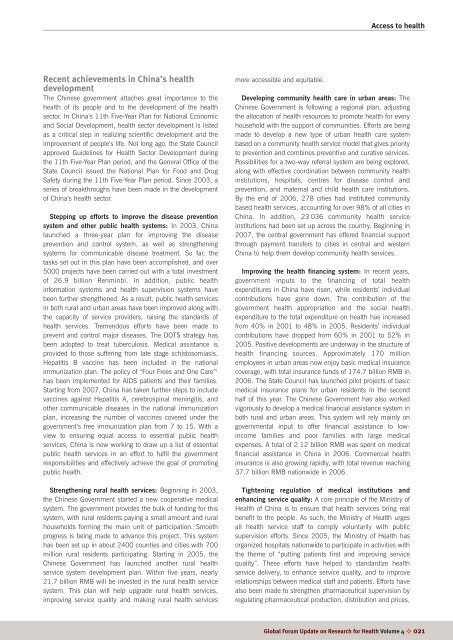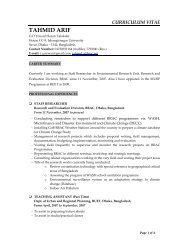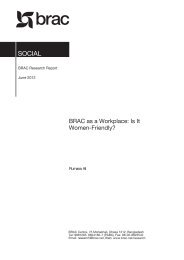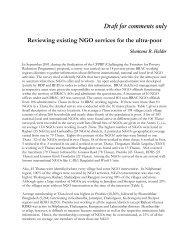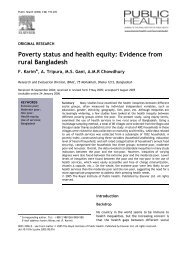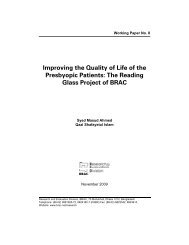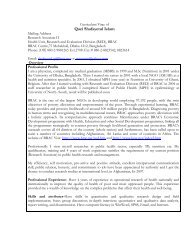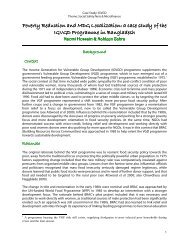Combining health and social protection measures to reach the ultra ...
Combining health and social protection measures to reach the ultra ...
Combining health and social protection measures to reach the ultra ...
Create successful ePaper yourself
Turn your PDF publications into a flip-book with our unique Google optimized e-Paper software.
Access <strong>to</strong> <strong>health</strong><br />
Recent achievements in China’s <strong>health</strong><br />
development<br />
The Chinese government attaches great importance <strong>to</strong> <strong>the</strong><br />
<strong>health</strong> of its people <strong>and</strong> <strong>to</strong> <strong>the</strong> development of <strong>the</strong> <strong>health</strong><br />
sec<strong>to</strong>r. In China’s 11th Five-Year Plan for National Economic<br />
<strong>and</strong> Social Development, <strong>health</strong> sec<strong>to</strong>r development is listed<br />
as a critical step in realizing scientific development <strong>and</strong> <strong>the</strong><br />
improvement of people’s life. Not long ago, <strong>the</strong> State Council<br />
approved Guidelines for Health Sec<strong>to</strong>r Development during<br />
<strong>the</strong> 11th Five-Year Plan period, <strong>and</strong> <strong>the</strong> General Office of <strong>the</strong><br />
State Council issued <strong>the</strong> National Plan for Food <strong>and</strong> Drug<br />
Safety during <strong>the</strong> 11th Five-Year Plan period. Since 2003, a<br />
series of breakthroughs have been made in <strong>the</strong> development<br />
of China’s <strong>health</strong> sec<strong>to</strong>r.<br />
Stepping up efforts <strong>to</strong> improve <strong>the</strong> disease prevention<br />
system <strong>and</strong> o<strong>the</strong>r public <strong>health</strong> systems: In 2003, China<br />
launched a three-year plan for improving <strong>the</strong> disease<br />
prevention <strong>and</strong> control system, as well as streng<strong>the</strong>ning<br />
systems for communicable disease treatment. So far, <strong>the</strong><br />
tasks set out in this plan have been accomplished, <strong>and</strong> over<br />
5000 projects have been carried out with a <strong>to</strong>tal investment<br />
of 26.9 billion Renminbi. In addition, public <strong>health</strong><br />
information systems <strong>and</strong> <strong>health</strong> supervision systems have<br />
been fur<strong>the</strong>r streng<strong>the</strong>ned. As a result, public <strong>health</strong> services<br />
in both rural <strong>and</strong> urban areas have been improved along with<br />
<strong>the</strong> capacity of service providers, raising <strong>the</strong> st<strong>and</strong>ards of<br />
<strong>health</strong> services. Tremendous efforts have been made <strong>to</strong><br />
prevent <strong>and</strong> control major diseases. The DOTS strategy has<br />
been adopted <strong>to</strong> treat tuberculosis. Medical assistance is<br />
provided <strong>to</strong> those suffering from late stage schis<strong>to</strong>somiasis.<br />
Hepatitis B vaccine has been included in <strong>the</strong> national<br />
immunization plan. The policy of “Four Frees <strong>and</strong> One Care” 1<br />
has been implemented for AIDS patients <strong>and</strong> <strong>the</strong>ir families.<br />
Starting from 2007, China has taken fur<strong>the</strong>r steps <strong>to</strong> include<br />
vaccines against Hepatitis A, cerebrospinal meningitis, <strong>and</strong><br />
o<strong>the</strong>r communicable diseases in <strong>the</strong> national immunization<br />
plan, increasing <strong>the</strong> number of vaccines covered under <strong>the</strong><br />
government’s free immunization plan from 7 <strong>to</strong> 15. With a<br />
view <strong>to</strong> ensuring equal access <strong>to</strong> essential public <strong>health</strong><br />
services, China is now working <strong>to</strong> draw up a list of essential<br />
public <strong>health</strong> services in an effort <strong>to</strong> fulfil <strong>the</strong> government<br />
responsibilities <strong>and</strong> effectively achieve <strong>the</strong> goal of promoting<br />
public <strong>health</strong>.<br />
Streng<strong>the</strong>ning rural <strong>health</strong> services: Beginning in 2003,<br />
<strong>the</strong> Chinese Government started a new cooperative medical<br />
system. The government provides <strong>the</strong> bulk of funding for this<br />
system, with rural residents paying a small amount <strong>and</strong> rural<br />
households forming <strong>the</strong> main unit of participation. Smooth<br />
progress is being made <strong>to</strong> advance this project. This system<br />
has been set up in about 2400 counties <strong>and</strong> cities with 700<br />
million rural residents participating. Starting in 2005, <strong>the</strong><br />
Chinese Government has launched ano<strong>the</strong>r rural <strong>health</strong><br />
service system development plan. Within five years, nearly<br />
21.7 billion RMB will be invested in <strong>the</strong> rural <strong>health</strong> service<br />
system. This plan will help upgrade rural <strong>health</strong> services,<br />
improving service quality <strong>and</strong> making rural <strong>health</strong> services<br />
more accessible <strong>and</strong> equitable.<br />
Developing community <strong>health</strong> care in urban areas: The<br />
Chinese Government is following a regional plan, adjusting<br />
<strong>the</strong> allocation of <strong>health</strong> resources <strong>to</strong> promote <strong>health</strong> for every<br />
household with <strong>the</strong> support of communities. Efforts are being<br />
made <strong>to</strong> develop a new type of urban <strong>health</strong> care system<br />
based on a community <strong>health</strong> service model that gives priority<br />
<strong>to</strong> prevention <strong>and</strong> combines preventive <strong>and</strong> curative services.<br />
Possibilities for a two-way referral system are being explored,<br />
along with effective coordination between community <strong>health</strong><br />
institutions, hospitals, centres for disease control <strong>and</strong><br />
prevention, <strong>and</strong> maternal <strong>and</strong> child <strong>health</strong> care institutions.<br />
By <strong>the</strong> end of 2006, 278 cities had instituted community<br />
based <strong>health</strong> services, accounting for over 98% of all cities in<br />
China. In addition, 23 036 community <strong>health</strong> service<br />
institutions had been set up across <strong>the</strong> country. Beginning in<br />
2007, <strong>the</strong> central government has offered financial support<br />
through payment transfers <strong>to</strong> cities in central <strong>and</strong> western<br />
China <strong>to</strong> help <strong>the</strong>m develop community <strong>health</strong> services.<br />
Improving <strong>the</strong> <strong>health</strong> financing system: In recent years,<br />
government inputs <strong>to</strong> <strong>the</strong> financing of <strong>to</strong>tal <strong>health</strong><br />
expenditures in China have risen, while residents’ individual<br />
contributions have gone down. The contribution of <strong>the</strong><br />
government <strong>health</strong> appropriation <strong>and</strong> <strong>the</strong> <strong>social</strong> <strong>health</strong><br />
expenditure <strong>to</strong> <strong>the</strong> <strong>to</strong>tal expenditure on <strong>health</strong> has increased<br />
from 40% in 2001 <strong>to</strong> 48% in 2005. Residents’ individual<br />
contributions have dropped from 60% in 2001 <strong>to</strong> 52% in<br />
2005. Positive developments are underway in <strong>the</strong> structure of<br />
<strong>health</strong> financing sources. Approximately 170 million<br />
employees in urban areas now enjoy basic medical insurance<br />
coverage, with <strong>to</strong>tal insurance funds of 174.7 billion RMB in<br />
2006. The State Council has launched pilot projects of basic<br />
medical insurance plans for urban residents in <strong>the</strong> second<br />
half of this year. The Chinese Government has also worked<br />
vigorously <strong>to</strong> develop a medical financial assistance system in<br />
both rural <strong>and</strong> urban areas. This system will rely mainly on<br />
governmental input <strong>to</strong> offer financial assistance <strong>to</strong> lowincome<br />
families <strong>and</strong> poor families with large medical<br />
expenses. A <strong>to</strong>tal of 2.12 billion RMB was spent on medical<br />
financial assistance in China in 2006. Commercial <strong>health</strong><br />
insurance is also growing rapidly, with <strong>to</strong>tal revenue <strong>reach</strong>ing<br />
37.7 billion RMB nationwide in 2006.<br />
Tightening regulation of medical institutions <strong>and</strong><br />
enhancing service quality: A core principle of <strong>the</strong> Ministry of<br />
Health of China is <strong>to</strong> ensure that <strong>health</strong> services bring real<br />
benefit <strong>to</strong> <strong>the</strong> people. As such, <strong>the</strong> Ministry of Health urges<br />
all <strong>health</strong> service staff <strong>to</strong> comply voluntarily with public<br />
supervision efforts. Since 2005, <strong>the</strong> Ministry of Health has<br />
organized hospitals nationwide <strong>to</strong> participate in activities with<br />
<strong>the</strong> <strong>the</strong>me of “putting patients first <strong>and</strong> improving service<br />
quality”. These efforts have helped <strong>to</strong> st<strong>and</strong>ardize <strong>health</strong><br />
service delivery, <strong>to</strong> enhance service quality, <strong>and</strong> <strong>to</strong> improve<br />
relationships between medical staff <strong>and</strong> patients. Efforts have<br />
also been made <strong>to</strong> streng<strong>the</strong>n pharmaceutical supervision by<br />
regulating pharmaceutical production, distribution <strong>and</strong> prices,<br />
Global Forum Update on Research for Health Volume 4 ✜ 021


